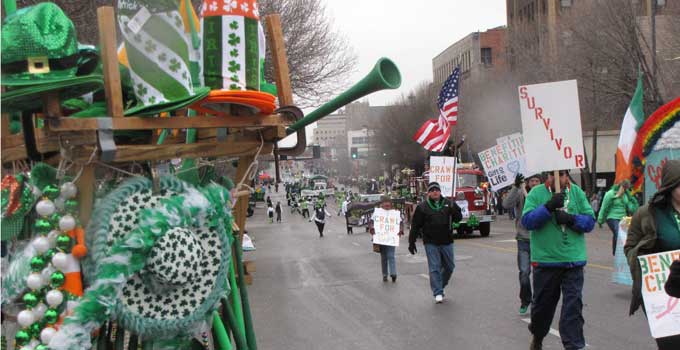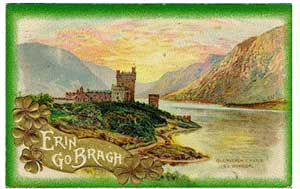
The Kansas City St. Patrick’s Day parade – said today to be the 6th largest in the country – started out strong in 1873, but by 1891, anti-Catholic sentiment drove it to a close. It wasn’t until 1973 that a conversation in a cocktail lounge brought it back to life. And for a while, after it came back to life, it was billed as the world’s shortest and worst parade.”
The whole history is told over at the Kansas City St. Patrick’s Day website.
“The 19th century Kansas City St. Patrick’s Day Parades were pageants of great pomp and circumstance. The Irish Benevolent Society would lead the processions composed of bands, police, and fire department personnel, and dignitaries of all descriptions (and quite often the German and Italian Benevolent Societies) from church to church in day-long extravaganzas often ending with grand balls,” it tells us.

A St. Patrick’s Day postcard from 1910. Image courtesy Kansas City Public Library, Missouri Valley Special Collections.
In his book From the Bottom Up: The Story of the Irish in Kansas City, Pat O’Neill, Jr. (a former parade co-chairman and son of one of its founders), wrote: “From 1873 to 1891, Kansas City’s exploding Irish population flexed first its pride and later its civic muscle with a series of parades, which highlighted daylong celebrations that included Catholic Mass, luncheon banquets, songs, suds, whiskey and temperance meetings.”
The parade grew in popularity and size from 1873. Still, the last big parade in 1891 marked “the beginning of a contentious era in which the specter of anti-Catholic sentiment grew vivid and violent,” the website tells us. “ In the ensuing years of unrest and tension that marked the heyday of anti-Catholic sentiment, the Irish parades all but disappeared. The Journal (a local newspaper) printed huge ghost images of St. Patrick, a shamrock, and a harp on its front page in 1893. The Times predicted that everybody of Irish descent would be wearing the green but sneered in a headline that there would be “No Parade, Luckily.”
The parade was resurrected in 1973 after a conversation at Hogerty’s Cocktail Lounge in downtown Kansas City between radio talk show host Mike Murphy, P.R. person Pat O’Neill, SR., and local saloon keeper Dan Hogerty.
“On Friday, March 15, 1973, Daniel Thomas Hogerty led a St. Patrick’s Day parade of secretaries, businessmen, and shoppers on what would again become a Kansas City Tradition. The block and one-half parade route led from the Continental Hotel back to Hogerty’s lounge, of course. Billed as “the world’s shortest and worst parade,” it drew hundreds of people to what became a downtown street party in the 1200 block of Baltimore,” the website says,
“By 1976, Hogerty, O’Neill, Murphy, and friends were joined by the honorable Mayor Charles Wheeler, and the parade featured a painted green calf along with several dogs and a goat. The City graciously parked a trash truck on Baltimore Avenue to collect the empty beer bottles,” it continues.
But by 1978, the parade was growing, with a crowd of 35,000 turning out to view it. The route was moved downtown in 1981, and the parade that year was reported to be the third largest in the country.
In 2009, the parade moved to Midtown, starting at Linwood and Broadway and proceeding south along Broadway to 43rd Street, a nod to the area’s Irish heritage.
“The area around Redemptorist Catholic Church where the parade starts was traditionally called Kerry Patch in the 1800s after the large Irish immigrant population living there. Many of the stone buildings in the neighborhood were built by Irish, and Irish quarried limestone in the Penn Valley Park area,” the website says.
Pingback: 🍀🍀 St Patrick’s Day in KC: Shamrocks and Shenanigans 🍀🍀 – B G Thomas – writer